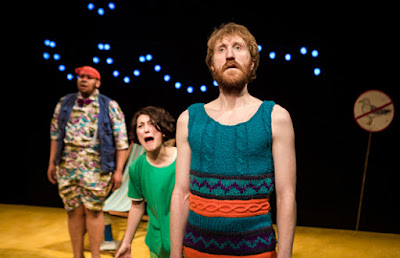'Jeramee, Hartleby and Oooglemore' review or 'Oooooooooglemore'
'Jeramee, Hartleby and Oooglemore', Gary Owen
Unicorn Theatre, 18th February 2016
The beautiful thing about ‘Jeramee,
Hartleby and Oooglemore’ is that it asks the same kind of questions of its
audience that any Tim Crouch show might – and has the same probing intelligence
you’d expect from writer Gary Owen – only everything has just been shifted a
little, shaded and highlighted in different ways. This is a show about the
limits of language and cause and effect - but it’s also a show about a jolly
trip to the seaside (painted with gorgeous bright sweeps by designer Lily
Arnold). But this is proper theatre, people – only it’s made for adults aged 3
years plus.
The big twist here is that the
actors don’t speak any dialogue – or, at least, not dialogue as we know it. Instead,
the actors only say each other’s names (in the most amazing range of emotions
imaginable). Not only that, the whole world on stage – lots of the details and
props – is made up of those names: the headline on Jeramee’s paper reads ‘Jeramee’
and the radio bleats out ‘Jeramee, Hartleby and Oooglemore’. When you’re this
young, the world is made up of those people closest to you. Your family becomes
your world. And, when you’re this young, language isn’t always the most useful
tool – it’s the meaning, emotion and physical impulses behind the words - as well as the awesome sounds those words
make - that matter.
We certainly don’t need words
to cotton on to the fact that Hartleby (Amalia Vitale) is a bit of a moody
madam, that her brother Oooglemore (Fionn Gill) is a slightly scruffy dreamer and
that Jeramee (Dorian Simpson) is a
patient soul, who responds well to calm behaviour from his young companions. The
children in the audience learn all of this by watching carefully. What’s so
interesting about eliminating language – or, at least, conventional language –
is that the young audience has to concentrate a lot harder, and so without
thought or complaint. They also get pulled into a physical dialogue rather than
verbal one. Oooglemore throws a massive beach ball into the crowd and we bounce
it back to him. When Oooglemore chucks the ball too hard, it disappears for
good. When Oooglemore and Hartleby tussle with a towel, they roll down the yellow
beach, over and over again. Cause and effect becomes the main method of
communication – and such a useful learning tool – as we watch reaction follow
action, again and again and again.
What’s weird and rather
amazing is how little time it takes for the children to catch onto this new
form of communication – and augment it. They start to fill in the gaps and
instinctively shout out commands and advice to the actors on-stage. Even more
intriguingly, the children gradually begin to speak Hartleby’s and Oooglemore’s
language and start screaming out their names in an attempt to reach them. It
doesn’t take the children long to acclimatize and, before we know it, the
family on-stage has expanded to include all of us, too. By the end of the show,
we have swum, danced and played together. Children’s worlds can be really quite
small – but they’re amazingly elastic and adaptable too, able to shift and
incorporate new people and ideas in an instant.



Comments
Post a Comment